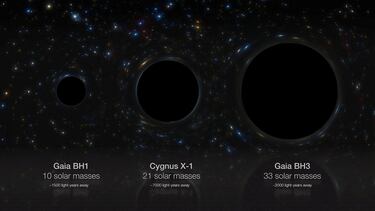How big is the newly discovered massive black hole in the Milky Way? How close is it to Earth?
Astronomers have discovered a new black hole in the Milky Way close to Earth and the largest known in our galaxy after the supermassive one at its center.

The European space telescope Gaia has discovered a new massive black hole in the Milky Way and relatively close to Earth. Designated Gaia-BH3, it is of stellar origin and a first of its kind found in our galaxy although they have been detected through gravitational wave observations in distant galaxies.
It’s a sleeping giant as it is ‘dormant’, emitting little or no radiation, meaning that it wasn’t be detected from X-ray emissions as most known black holes are found. Those are produced when material from a companion star is devoured by a black hole. However, in this case Gaia-BH3, which forms a forms a wide binary system, was observed due to its gravitational effect on its companion star.
Researchers are ecstatic about the discovery. “It’s a real unicorn! It’s like nothing we’ve ever seen.” lead author of the study Pasquale Panuzzo of CNRS in France said. While it confirms certain theories, others will potentially require review. However, it raises the prospect of finding even more black holes with even greater masses.
How close is the new black hole to Earth?
By space standards, Gaia-BH3 is in Earth’s neighborhood a mere 2,000 light years away. For perspective, Sagittarius A*, or Sgr A*, the supermassive black hole at the heart of the Milky Way is 26,000 light years from Earth.
However, Gaia-BH3 isn’t the closest. Another black hole detected two years ago also by Gaia, is 1,560 light-years away. Gaia-BH1 is about average for the Milky Way with a mass of around 9.6 times that of our Sun.
How big is the newly discovered massive black hole in the Milky Way?
Researchers were able to measure the mass of Gaia-BH3 by observing the wobble of its companion star. It was calculated to have a mass roughly 33 times greater than that of our Sun. It is the largest stellar-mass black hole in the Milky Way, and the second largest celestial object of its kind after the supermassive black hole at the center of our galaxy.

Related stories
Sagittarius A* has a mass around 4.2 million times that of the sun. Unlike stellar black holes, Sgr A* and its ilk are formed as bigger and bigger black holes merge together. Stellar black holes form when a massive star of sufficient mass collapses in on itself when it dies and continues collapsing inward.
The next biggest stellar black hole in our galaxy with a mass roughly 20 times that of our Sun is Cyg X-1, found in the Cygnus constellation, which was the first black hole to be confirmed by researchers in 1971. The average black hole of this class has a mass of about 10 Suns.



Complete your personal details to comment